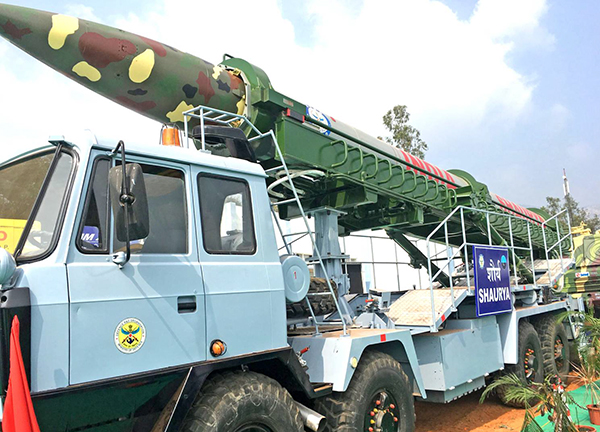India, on 3 October, successfully test-fired a new version of the nuclear-capable hypersonic Shaurya missile with a range of 750 kilometres from a defence facility off the Odisha coast. This was the first-ever user-specific trial of the indigenously developed hypersonic nuclear-capable Shaurya missile.
Shaurya is the land version of the submarine-launched BA-05 missile and has been developed by the DRDO. The missile used in the 3 October test was a land version missile. It was tested discreetly tested for the final time before induction as part of user trials. The missile can fly at supersonic speeds of Mach 7 at a height of 50 km and can hit the target at Mach 4 speed with a warhead weighing around 160 kilograms.
The surface-to-surface medium range Shaurya missile, blasted off from a canister from the Abdul Kalam Island test range off Dhamra. The canister-launched missile has been developed by the DRDO. It was test-fired with a dummy payload from a land-based platform in a fully operational configuration.
ALSO READ: FUTURE TECHNOLOGIES : Hypersonic Weapons – The New Arms Race
The missile, equipped with multiple advanced computing technology and high accuracy navigation, efficient propulsion, sophisticated control and guidance systems, successfully followed its target in the Bay of Bengal.
The indigenously-developed missile was tracked and monitored through an integrated system of sophisticated radars, electro-optical tracking instruments and a chain of telemetry stations positioned in different points, they said. It performed a manoeuvre in the terminal phase and hit the impact point. It was the first user-specific trial of the missile that is a land variant of submarine-launched ballistic missile K-15.
The two-stage missile that uses solid propellants can deceive enemy radars after launch, the officials said. The 10 metre-long missile – weighing 6.2 tonne – can carry both nuclear and conventional warheads weighing up to 1,000 kilograms. The missile has a strike range of 700 to 1,800 kilometres and can carry warheads with a payload of up to a tonne. It boasts of a two-engine system which accelerates it to six times the speed of sound before it reaches the height of 50 kilometres, post which it cruises towards the intended target.
Highly manoeuvrable, the missile is less vulnerable to anti-ballistic missile defence systems, thus adding to its strategic importance. It boasts of unique capability, wherein it can guide itself up to the target like a cruise missile while being powered by solid fuel like a ballistic missile. Once launched, Shaurya would be difficult to track by radars as the window for detection, tracking and interception is only 400 seconds. Like the BrahMos supersonic cruise missile, Shaurya can be stored in a composite canister, making it easier to handle and transport.
Like a ballistic missile, it is powered by solid fuel, but can guide itself up to the target like a cruise missile, the officials added.
The test was significant as it was one of the China-specific missiles developed by the nation. If launched from a submarine off the Chinese coast, the missile can cover many of the major Chinese cities.
The government has quietly approved induction and deployment of Shaurya strategic missile even as forward movement has been recorded in development of 5,000 km range K-5 submarine-launched ballistic missile.
Shaurya is a delivery system stored in a composite canister for rapid deployment and minimum interaction with the elements for a long period. The strategic missile flies at a supersonic speed of Mach 7, or 2.4 km per second, at a height of 50 km (within atmosphere) and hits the designated target at Mach 4.
The missile will be soon deployed at locations identified by the Indian Strategic Forces Command under guidance from National Security Council.


















